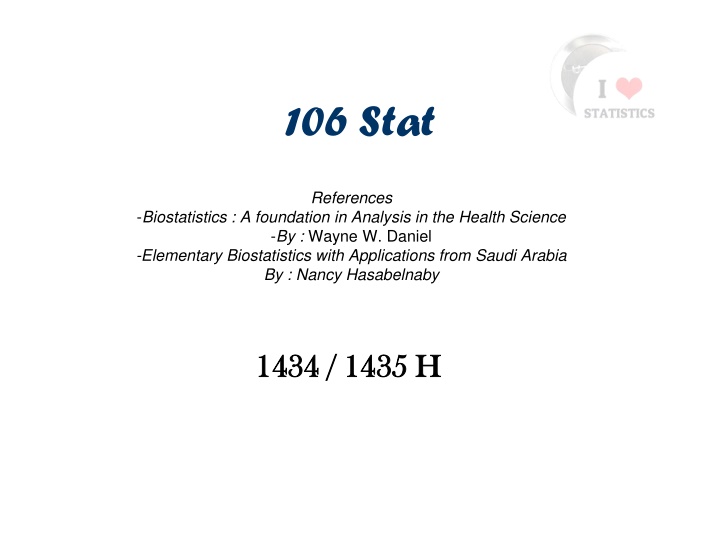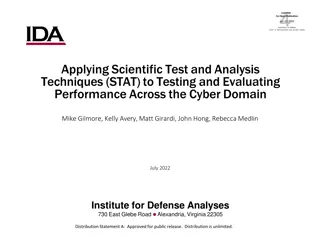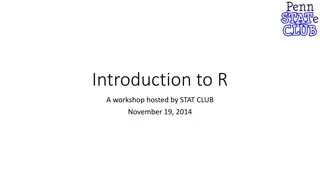
Variables in Biostatistics
Explore the fundamental concepts of variables in biostatistics, including qualitative vs. quantitative distinctions, discrete vs. continuous variables, and examples illustrating their application in healthcare research.
Download Presentation

Please find below an Image/Link to download the presentation.
The content on the website is provided AS IS for your information and personal use only. It may not be sold, licensed, or shared on other websites without obtaining consent from the author. If you encounter any issues during the download, it is possible that the publisher has removed the file from their server.
You are allowed to download the files provided on this website for personal or commercial use, subject to the condition that they are used lawfully. All files are the property of their respective owners.
The content on the website is provided AS IS for your information and personal use only. It may not be sold, licensed, or shared on other websites without obtaining consent from the author.
E N D
Presentation Transcript
106 Stat References -Biostatistics : A foundation in Analysis in the Health Science -By : Wayne W. Daniel -Elementary Biostatistics with Applications from Saudi Arabia By : Nancy Hasabelnaby 1434 1434 / / 1435 1435 H H
Stat 106 Dr.Arwa Alameen Alshingiti Chapter 1: Organizing and Displaying Data 1.1: Introduction Here we will consider some basic definitions and terminologies ( ) Statistics: Is the area of study that is interested in how to organize and summarize information and answer research questions. Biostatistics: Is a branch of statistics that interested in information obtained from biological and medical sciences. Population: Is the largest group of people or things in which we are interested in a particular time and about which we want to make some statement or conclusions. Sample: A part of the population on which we collect data. The number of the element in the sample is called the sample size and denoted by n. Variable: the characteristic to be measured on the elements of population or sample. 2
Stat 106 Dr.Arwa Alameen Alshingiti Types of variables Qualitative: If the values of the variables are word indicating to which category an element of the population belongs. Quantitative; if the value of the variable are numbers indicating how much or how many of something Discrete: Can have countable numbers of values ( there are gaps between the values) Nominal: the value of the variables are names only Continuous: Can have any value within a certain interval of values. it is usually measured on some scale in terms of some measurement units like kilograms, meters etc Ordinal: variables can be ordered. Examples: Educational level: elementary ,intermediate, high school. Blood pressure: Low, medium, high Examples: *Gender: Female or male. * Eye colour: Black, brown, green, etc Examples: *Number of patients admitted to a hospital in one day (x=1,2, ) * Number of pain killer tablets (x= 0.5,1,1.5,2 ,2.5, ) Examples: *Level of chemical in drinking water *height (140<x<190) *blood sugar level of a person. Note: Discrete values can take either integer values or decimal values with gaps between the values. 3
Stat 106 Dr.Arwa Alameen Alshingiti Example 1 Suppose we measure the amount of milk that a child drinks in a day (in ml) for a sample of 25 two-years children in Saudi Arabia. The population: all two years children in Saudi Arabia The variable: the amount of milk that a child drink in a day (in ml) The variable is quantitative, continuous. The sample size is 25. Example 2 Suppose we measure weather or not a child has a hearing loss for a sample of 20 young children with a history of repeated ear infections. The population: all young children with a history of repeated ear infection. The variable: whether or not a child has a hearing loss The variable is qualitative, nominal. Since the values are either yes or no . The sample size is 20 4
Stat 106 Dr.Arwa Alameen Alshingiti Example 3 Suppose we measure the temperature for a sample of 25 animals having a certain disease. The population The variable The type of the variable The sample size -------------------------------------------------------------------------- 5
Stat 106 Dr.Arwa Alameen Alshingiti 1.2 Organizing the Data Suppose we collect a sample of size n from a population of interest. A first step in organizing is to order the data from smallest to largest (if it is not nominal). A further step is to count how many numbers are the same (if any). The last step is to organize it into a table called frequency table (or frequency distribution). The frequency distribution has two kinds 1) Simple (ungrouped) frequency distribution: for 2) Grouped frequency distribution: for Qualitative variables Discrete quantitative with small number of different variables Continuous quantitative variables Discrete quantitative with large number of different variables. 6
Stat 106 Dr.Arwa Alameen Alshingiti Example 1.2.1: (simple frequency distribution) Suppose we are interested in the number of children that a Saudi woman has and we take a sample of 16 women and obtain the following data on the number of children 3, 5, 2, 4, 0, 1, 3, 5, 2, 3, 2, 3, 3, 2, 4, 1 Q1: What is the variable? The population? and the sample size?. What are the different values of the variable? -the different values are: 0,1,2,3,4,5 Q2: Obtain a simple frequency distribution (table)? If we order the data we obtained 0, 1 ,1 ,2 , 2, 2, 2, 3, 3, 3, 3, 3, 4, 4, 5, 5 To obtain a simple frequency distribution (table) we have to know the following concepts The frequency: is obtained by counting how often each number in the data set . The sample size (n): is the sum of the frequencies. Relative frequency= frequency/n Percentage frequency= Relative frequency*100= (frequency/n)*100. 7
Stat 106 Dr.Arwa Alameen Alshingiti Simple frequency table for the number of children. Number of children (variable) frequency of women (frequency) Relative frequency Percentage frequency 0 1 0.0625 6.25 1 2 0.125 12.5 2 4 0.25 25 3 5 0.3125 31.25 4 2 0.125 12.5 5 2 0.125 12.5 Total n=16 1 100 -------------------------------------------------------------------------------------- The simple frequency distribution has the frequency bar chart as graphical representation Frequency bar chart of the number of children Exercise: for more exercises and details about graphs http://onlinestatbook.co m/chapter2/graphing_q ualitative.html 6 Frequency of women 5 4 3 2 1 0 0 1 2 3 4 5 Number of children 8
Stat 106 Dr.Arwa Alameen Alshingiti Example 1.2.2 :grouped frequency distribution The following table gives the hemoglobin level (in g/dl) of a sample of 50 apparently ( ) healthy men aged 20-24. Find the grouped frequency distribution for the data. 17 17.1 14.6 14 16.1 15.9 16.3 14.2 16.5 -What is the variable? The sample size? - The max=18.8 -The min=13.5 -The range=max-min=18.8-13.5=4.8 17.7 15.7 15.8 16.2 15.5 15.3 17.4 16.1 14.4 15.9 17.3 15.3 16.4 18.3 13.9 15 15.7 16.3 15.2 13.5 16.4 14.9 15.8 16.8 17.5 15.1 17.3 16.2 16.3 13.7 17.8 16.7 15.9 16.1 17.4 15.8 Notes 1. 2. In example 1.2.2 to group the data we use a set of intervals, called class intervals. The width (w) is the distance from the lower or upper limit of one class interval to the same limit of the next class interval. Let we denote the lower limit and upper limit of the class interval by L and U, that is the first class is L1-U1, the second class is L2-U2 To find the class intervals we use the following relationship 3. 4. L1 U1 +w +w L2 U2 +w 9 +w L3 U3 and so on
Stat 106 Dr.Arwa Alameen Alshingiti 6. Cumulative frequency: is the number of values obtained in the class interval or before, which find by adding successfully the frequencies. 7. Cumulative relative frequency: is the proportion of values obtained in the class interval or before, which find by adding successfully the relative frequencies. 8. The Grouped frequency distribution for Example 1.2.2 is Relative frequency Cumulative frequency Cumulative relative frequency Class Interval Frequency 13 - 13.9 3 0.06 3 0.06 14 - 14.9 5 0.1 8 0.16 15 - 15.9 15 0.3 23 0.46 16 - 16.9 16 0.32 39 0.78 17 - 17.9 10 0.2 49 0.98 18 - 18.9 1 0.02 50 1 Total n=50 1 ------------------------------------------------------------------------------------------------------------------------------------------------ 1.3 True classes and displaying grouped frequency distributions ( To Find the true class intervals we have two ways: 1) Subtract from the lower limit and add to the upper limit one- half of the smallest unit. 2) Decrease the last decimal place of the lower limit by 1 and put 5 after it, and for the upper limit we simply put 5 after the limit. 10
Stat 106 Dr.Arwa Alameen Alshingiti True class True class 13 13.9 14 14.9 13.95 15 12.95 14.95 s.u=0.1 To illustrate this let us find the true classes of example 1.2.2 Class Interval True class interval Mid points Frequency 13.0 - 13.9 12.95 - <13.95 13.45 3 14.0 - 14.9 13.95 - <14.95 14.45 5 15.0 - 15.9 14.95 - <15.95 15.45 15 16.0 - 16.9 16.95 - <16.95 16.45 16 17.0 - 17.9 16.95 - <17.95 17.45 10 18.0 - 18.9 17.95 - <18.95 18.45 1 Total n=50 Notes: - Each upper limit of the true class interval ends with the same lower limit of the previous true class intervals The lower and upper limit of the true class interval must always end in 5, and they must always have one more decimal place than class limit. The mid point =(upper limit + lower limit)/2. To find the midpoint of the interval we simply add the width to the previous midpoint. - - - 11
Stat 106 Dr.Arwa Alameen Alshingiti 1.4 Displaying grouped frequency distributions Grouped frequency distributions can be displayed by Histogram Polygon For frequency or relative frequency distributions curves Frequency Histogram 18.95 12.95 14.95 15.95 16.95 17.95 13.95 12 15.95 Hemoglobin Level
Stat 106 Dr.Arwa Alameen Alshingiti Frequency 12.45 13.45 14.45 15.45 16.45 17.45 18.45 19.45 Exercises: 1.R.1 (a-c-d-e) , 1.R.2 (a-c-d-e), 1.R.5 pg 25 13
Stat 106 Exammple 1.4: In the study, the blood glucose level (in mg/100 ml) was measured for a sample from all apparently healthy adult males. Dr.Arwa Alameen Alshingiti a) b) Identify variable and the population in the study. From the table, find Class interval (glucose level ) Relative frequency Cumulative frequency Frequency 0.04 0.16 3 3 1. 70-79 80-89 90-99 15 39 12 2. 0.32 24 3. 0.4 69 75 100-109 30 6 4. 110-119 0.08 5. Total 75 1 1) w= 2) n= 3) The number of healthy males with glucose level 80-89 mg/100 ml 4) The percentage of healthy males with glucose level less than 100-109 mg/100 ml 5) The number of healthy males with glucose level less than 99 mg/100 ml 6) The number of healthy males with glucose level greater than 100 14
Stat 106 Chapter 2: Basic Summary Statistics 2.1: Introduction This chapter concerns mainly about describing the middle of the observations and how spread out they are. Measures of central tendency Dr.Arwa Alameen Alshingiti Measures of dispersion Measures which are in some sense indicate where the middle or centre of the data is. (e.g.Mean, median and mode) Measures which indicate how spread out the observation from each other. (e.g. Range, variance, standard deviation and coefficient of variation) 15
Stat 106 Dr.Arwa Alameen Alshingiti Population The population values of the variable of interest: X1, X2, , XN (usually they are unknown). N=The population size Any measure obtained from the population values of the variable of interest is called a parameter Sample the sample values of the variable : x1, x2, , xn n= the sample size. Any measure obtained from the sample values of the variable of interest is called a statistics 16
Stat 106 Dr.Arwa Alameen Alshingiti 2.2: Measures of central tendency We use the term central tendency to refer to the natural fact that the values of the variable often tend to be more concentrated about the centre of the data. We will consider three such measures: the mean, the median and the mode. Mean: (or average) Population mean: let X1,X2, , XN be the population values of the variable (usually unknown), then the population mean is unknown N = Parameter X + + + ... X X X i = 1 2 N N Sample mean :let x1, x2, , xn be the sample values of the variable, then the sample mean is The sample mean is an estimator of a population mean. Question: which one is a parameter and which one is a statistic? n = x + + + ... x x x Known from the sample estimator of a population mean i = 1 2 x n n Statistic Example 2.1: Consider a population consisting of the 5 nurses who work in a particular clinic, and we are interested in the age of these nurses in years X1=30, X2=22, X3=35, X4=27, X5=41 Then average nurse population is years. 5 5 + + + + 30 22 35 27 41 155 = = = 31 17
Stat 106 Dr.Arwa Alameen Alshingiti Median (or med)The median is the middle value of the ordered observation To find the median of a sample of n observation, we first order the data, then 1) If n is odd, the middle observation is the order (n+1)/2. 2) If n is even, the middle two observations are the n/2 and the next observation, the median is the average of them. Example 2.2.1:Find the median of the following samples a) 29, 30, 32, 31, 28, 29, 30, 42, 40, 40, 40. First we order the data 28, 29, 29, 30, 30, 31, 32, 40, 40, 40, 42 n= 11, odd, the order of the median is (n+1)/2=(11+1)/2=6th 28, 29, 29, 30, 30, 31, 32, 40, 40, 40, 42 med=31 (unit) b) 1.5, 3.0, 18.5, 24.0, 12.0, 4.5, 6.0, 9.5, 10.5, 15.0, 11.0, 11.5 n=12, even, n/2=6th , hence we take the average of the 6th and the 7th value The ordered sample is 1.5, 3.0, 4.5, 6.0, 9.5, 10.5, 11, 11.5, 12.0, 15.0, 18.5, 24.0 med=(10.5+11)/2=10.75 (unit) 6th 7th 6th 18
Stat 106 Dr.Arwa Alameen Alshingiti Mode (or modal) The mode of set of values is that value which occurs with highest frequency . Any data must has one of the three cases No mode: example: Data(1): 21, 15, 22 ,19, 14, 18 Data(2): 3, 3, 5,5, 4, 4, 6, 6 One mode, example :Data (1): 32, 15, 23, 17 , 22, 23, 19, 20, 22, 22 . The mode=22 (unit) Data(2): 13.5, 12, 13.5, 15, 15, 14.6, 17, 12, 15 The mode=15 (unit) More than one mode: example 18, 20, 19, 19, 21, 17, 20 modes: 19 , 20 (unit) ----------------------------------------------------------------------------------------- Notes: Mean and median can only be found for quantitative variables, the mode can be found for quantitative and qualitative variables. There is only one mean and one median for any data set. The mean can be distorted by extreme values so much. measures that not affected so much by extreme values are the median and the mode. Animated example on the web: http://standards.nctm.org/document/eexamples/chap6/6.6/index.htm 19
Example 2.2.2 The following table shows the computer results of the country of manufacturing of 50 conditioner devices Frequency Percent Valid Percent 62.0 16.0 22.0 100.0 Cumulative Percent 62.0 78.0 100.0 Valid American European Japanese Total 31 8 11 50 50 62.0 16.0 22.0 100.0 100.0 Total From this table: A)What is the variable, what is the type of the variable ? B) The number of Japanese-made devices is (a) 22 (b) 16 C) The percentage of American-made devices is (a) 22 % (b) 31% D) The mode of country-made devices is (a) Japanese (b) European (c) American(d) American and Japanese (e)No mode E) If we want to represent this type of data, we will use (a) Histogram (b) Line chart (c) Pie chart (c) 62 (d) 50 (e)11 (c) 62% (d) 50% (e)100% (d) Bar chart (e) we can't
Example 2.2.3 A sample of 80 families have been asked about the number of times to travel abroad. The computer results of the SPSS are given below Frequency Percent Valid Percent Cumulative Percent 13.8 22.5 28.8 36.3 46.3 53.8 61.3 73.8 81.3 88.8 95.0 97.5 98.8 100.0 Valid 0 1 2 3 4 5 6 7 8 9 11 7 5 6 8 6 6 10 6 6 5 2 1 1 80 80 13.8 8.8 6.3 7.5 10.0 7.5 7.5 12.5 7.5 7.5 6.3 2.5 1.3 1.3 100.0 13.8 8.8 6.3 7.5 10.0 7.5 7.5 12.5 7.5 7.5 6.3 2.5 1.3 1.3 100.0 10 11 12 13 Total Total
From above table: A) The variable is (a) Number of families (b) Number of times to Travel abroad (c) None of these B) The type of the variable is (a) Quantitative Discrete (d) Normal (e) Binomial (b) Qualitative (c) Quantitative Continuous (f) None of these C) Number of families that travelled abroad 7 times is (a) 7.5 (b) 0 (c) 6 (d) 1 (e) 53.8 (f)10 D) The percentage of families that travelled abroad less than or equal to 10 times is (a) 73.8% (b) 0 (c)100% (d) 88.8% (e) 5% (f) 95% E) The mode of travel times is (a) 13.8 (b) 0 (e) 80 (c) 6 (d) 11 (f)13
Example 2.2.4 By using the computer results of SPSS the plot of the number of courses in English that student takes in a year is obtained: 12 10 8 Frequancy 6 4 2 0 1 2 3
1) The type of the graph is: a) Bar chart (b) polygon (c) histogram (d) line (e) curve 2)The Variable is: a) Number of students (b) number of courses (c) English (d) Arabic 3) The total number of students who study in English is: a) 0 (b) 25 (c) 12 (d) 6 (e) 3 4) The number of students who study two courses in English is: a) 0 (b) 2 (c) 7 (d) 8 (e) 5 5)The number of students who study at least two courses in English is: a)7 (b) 8 (c) 15 6)The percent of students who study at most one course in English is: a)7% (b) 18% (c) 28% (d) 60% (d) 18 (e) 25 (e) 72% 7) The sample mean is a)2.55 (b) 255 (c) 3 (d) 3.1875 (e) 40 8)The sample mode is a)0 (b) 3 (c) 10 (d) 2 (e) no mode
Stat 106 Dr.Arwa Alameen Alshingiti 2.3: Measure of dispersion The variation or dispersion in a set of observations refers to how spread out the observations are from each other. -When the variation is small, this means that the observations are close to each other (but not the same). - Can you mention a case when there is no variation? Larger variation Smaller variation Same mean Smaller variation Larger variation We will consider four measures of dispersion: the range, the variance, the standard deviation and the coefficient of variation. 25
Stat 106 Dr.Arwa Alameen Alshingiti Range (R):Is the difference between the largest and smallest values in the set of values Example 2.3(q2.6- pg 35):Below are the birth weights (in kg) for a sample of babies born in Saudi Arabia: 1.69, 1.79, 3.32, 3.26, 2.71, 2.42, 2.59, 1.05, 3.19, 3.40, 3.23, 3.37, 3.6, 3.63 - Find the mean, mod and median. - R=3.63-1.05=2.58. Note: The range is easy to calculate but it is not useful as a measure of variation since it only takes into account two of the values. Variance:Is a measure which uses the mean as point of reference. Population variance: let X1,X2, , XN be the population values of the variable (usually unknown), then the population variance is where is the population mean. = N 2 ( ) X i = 2 1 i N Sample Variance :let x1, x2, , xn be the sample values of the variable, then the = = n n 2 ( ) x x sample variance is where is the sample mean. 1 x i 2 1 i s 26
Stat 106 Dr.Arwa Alameen Alshingiti Notes: The variance is less when all the values are close to the mean, while it is more when all the values are spread out of the mean. xi x xn x1 x2 x 2 ( ) x 2 xi 2) ( x x 2 ( ) x 1 xn 2) ( x 2 2 s , 0 0 The variance is always a nonnegative value ( ). Population variance is usually unknown (parameter), hence it is estimated by the sample variance (statistic). A simpler formula to use for calculating sample variance is The variance is expressed in squared unit. 2 2s = = n 2 i 2 ( ) x n x 2 1 i s 1 n 27
Stat 106 Dr.Arwa Alameen Alshingiti Standard deviation (std. dev.): The standard deviation is defined to be the root of the variance. Population standard deviation Sample standard deviation = n 2 i 2 ( ) x n x = N 2 ( ) = = X 2 1 i s s i = = 2 1 i 1 n N 28
Stat 106 Dr.Arwa Alameen Alshingiti Coefficient of variation (CV): - The variance and standard deviation are useful as measures of variation of the values of single variable for a single population. - If we want to compare the variation in two data set the variance and standard deviations may give misleading results because: - The two variable may have different units as kilogram and centimeters which cannot be compared. - Although the same units are used, the mean of the two may be quit different in size. - The coefficient of variation (CV) is used to compare the relative variation in two data set and it dose not depend on either the unit or how large the values are, the formula of CV is given by s =x CV 100 (%) - Suppose we have two data set as the following and we want to compare the variation mean Std.dev. CV s =x Set 1 s1 1x 2 x CV 100 (%) 1 1 1 s Set2 s2 =x CV 100 (%) 2 2 29 2
Stat 106 Dr.Arwa Alameen Alshingiti Then we say that the variability in the first data set is larger than the variability in the second data set if CV1> CV2 (and vice versa). Example 2.5 Suppose two sets of samples of human males of different ages give the following results weight set1: on males aged 29: =66kg s1=4.5kg CV1=(4.5/66) 100%=6.8% set2: on males aged 10: =36kg s1=4.5kg CV2=(4.5/36) 100%=12.5% Since CV2> CV1 , the variability in the weight of the 2nd set (10-years old) is greater than the variability in the 1st data set (29-years old). 1x 2x Examples: 2.9 +2.11 pg 41 --------------------------------------------------------------------------------------------------- A site that explains the concepts in Arabic http://www.jmasi.com/ehsa/ A site that explains how to use SPSS for descriptive statistics http://academic.udayton.edu/gregelvers/psy216 /spss/descript1.htm 30
Example 2.4.1 For a sample of patients, we obtain the following graph for approximated hours spent without pain after a certain surgery 30 25 25 20 frequency 15 15 15 10 10 10 5 5 0 1.0 2.0 3.0 4.0 5.0 6.0 Hours
1) The type of the graph is: a) Bar chart (b) polygon (c) histogram (d) line (e) curve 2) The number of patients stayed the longest time without pain is: a) 10 (b) 15 (c) 6 (d) 5 (e) 80 3)The percent of patients spent 3.5 hours or more without pain is: a)37.5% (b) 68.75% (c) 18.75% (d) 50% (e) 25% 4)The lowest number of hours spent without pain is: a)10 (b) 1 (c) 0.5 (d) 5 (e) 25 (f) 6.5 5)What the approximate value of the sample mean a)2.55 (b) 255 (c) 3 (d) 3.1875 (e) 40 (f) we can't find it 6)The sample mode equals a)80 (b) 3 (c) 15 (d) 2,4 (e) 6 (f) we can't find it
The SPSS computer results of the age of patients in one of the Riyadh hospitals are given below Find : a) Variable name a) b) c) d) e) f) g) The type of the variable The mode The mean age of the patients The median age of the patients The variance Sample size The coefficient of variation 33
Stat 106 Dr.Arwa Alameen Alshingiti 2.4: Calculating measures from an ungrouped frequency tables: Suppose we have the following frequency table, where mi is the ithvalue in the ungrouped frequency table or the midpoint in the grouped frequency table, and fiis the ithfrequency. The formulas for sample mean and variance will be modified as follows: n= fi (the sample size= the sum of frequencies) k=number of distinct values (or number of intervals) , x x = n 1 n Value (or midpoint) frequency m1 m2 f1 f2 mk fk fi=n n k = n i k i 2 2 x m f = x m f i i i = = i i i 1 1 = = 1 1 i i i = n = = = n k 2 i 2 ( ) x n x m f k i 2 i 2 = n ( ) m f n x i i i 1 2 1 1 i i s x 2 i 1 s n 1 For using calculator to find the mean, variance and standard deviation, you can visit the site http://faculty.ksu.edu.sa/alshangiti 34
Stat 106 Dr.Arwa Alameen Alshingiti Notes: When data are grouped we cannot determine from the frequency distribution what the actual data values are but only how many of them are in the class interval. We can t find the actual values for the sample mean and sample variance but we can find approximation of them. For grouped data we assume that all values in particular class interval are located at the midpoint of the interval (mi ) because the mid point is best representative for whole interval 35
Stat 106 Dr.Arwa Alameen Alshingiti Example 2.6: Suppose that in a study on drug consumption by pregnant Saudi women, the number of different drugs taking during pregnancy was determined for a sample of Saudi women who took at least one medication obtaining: Value mi 1 2 3 4 5 6 7 Frequency fn 5 11 7 3 2 1 1 Cumulative frequency mifn mi2fn 5 16 23 26 28 29 30 5 22 21 12 10 6 7 5 44 63 48 50 36 49 Total n=30 83 295 Find the measure of central tendency and dispersion. Solution: n=30 - =83/30=2.7666 2.8 drugs - To find the median: since n=30 is even, the order of the two middle values is n/2=15th and 16th, from the cumulative frequency the 16th and 15th ordered observation is 2, and hence - Med=(2+2)/2=2 drugs x 36
Stat 106 Dr.Arwa Alameen Alshingiti The mode - is 2 since it has the highest frequency. 2 2 m s The variance The range The standard deviation The coefficient of variation 2 = ( ) f n x 2 295 7666 . 2 )( 30 ( ) i i = = . 2 25 Note: we didn t put any unit here variable is discrete, the word (drug) is just an indicator of what we are counting 1 29 n since the - : R=7-1=6 - - ============================================================= Example 2.7: The following are the ages of a sample of 100 women having children who were admitted to a particular hospital in Madinah in particular month. s= =1.5 =(1.5/2.8) 100=53.6 % . 2 25 Class Interval 15-19 20-24 25-29 30-34 35-39 40-44 Total Mid points Frequency 17 22 27 32 37 42 8 16 32 28 12 4 n=100 37 Find the mean, the variance, and the coefficient of variation.
Stat 106 Dr.Arwa Alameen Alshingiti Chapter 3: Some Basic Probability Concepts 3.1 General view of probability Probability:The probability of some event is the likelihood (chance) that this event will occur. An experiment: Is a description of some procedure that we do. The universal set ( ): Is the set of all possible outcomes, An event: Is a set of outcomes in which all have some specified characteristic. Notes: 1. (the universal set) is called sure event 2. (the empty set) is called impossible event 38
Stat 106 Dr.Arwa Alameen Alshingiti Example (3.1) Consider a set of 6 balls numbered 1, 2, 3, 4, 5, and 6. If we put the sex balls into a bag and without looking at the balls, we choose one ball from the bag, then this is an experiment which is has 6 outcomes. ={1, 2, 3, 4, 5 ,6 } Consider the following events E1=the event that an even number occurs={2, 4, 6}. E2=the event of getting number greater than 2={3,4, 5, 6}. E3=the event that an odd number occurs={1, 3, 5}. E4=the event that a negative number occurs={}= . 39
Stat 106 Dr.Arwa Alameen Alshingiti Equally likely outcomes: The outcomes of an experiment are equally likely if they have the same chance of occurrence. Probability of equally likely events consider an experiment which has N equally likely outcomes, and let the numbers of outcomes in an event E given by n(E), then the probability of E is given by ) ( ) ( N n E ( ) n E =n P E = ( ) Notes 1. For any event A , 0 P(A) 1 (why?) That is, probability is always between 0 and 1. 2. P( )=1, and P( )=0 (why?) 1 means the event is a certainty, 0 means the event is impossible 40
Stat 106 Dr.Arwa Alameen Alshingiti Example (3.2) In the ball experiment we have n( )=6, n(E1)=3, n(E2)=4 , n(E2)=3 P(E1)=3/6=0.5 Repaper that P(E2)=4/6=0.667 E1=the event that an even number occurs={2, 4, 6}. E2=the event of getting number greater than 2={3,4, 5, 6}. E3=the event that an odd number occurs={1, 3, 5}. E4=the event that a negative number occurs={}= . P(E3)=3/6=0.5 P(E4)=0 41
Stat 106 Dr.Arwa Alameen Alshingiti Relationships between events : A B, consists of all those outcomes in A or in B or in both A Union and B B A A B ------------------------------------------------------------------------------------------------------------------------------------------------------------------------------------------------------------- : A B, consists of all those outcomes in both A and B B Intersection A A B ------------------------------------------------------------------------------------------------------------------------------------------------------------------------------------------------------ : Ac (or A`) Consists of all outcomes that are in but not in A Complement A Ac 42
Stat 106 Dr.Arwa Alameen Alshingiti Notes: 1- n(A B)= n(A)+n(B)-n(A B) and hence P(A B)= P(A)+P(B)-P(A B) B A 2. n(Ac)=n( )- n(A) So that P(Ac)=1- P(A) A Ac Sets (events) can be represented by Venn Diagram B A A Bc Ac B A B Ac Bc 43
Stat 106 Dr.Arwa Alameen Alshingiti Disjoint events Two events A and B are said to be disjoint (mutually exclusive) if A B= . - P(A B)=0 P(A B)= P(A)+P(B) In the case of disjoint events B A 45
Stat 106 Dr.Arwa Alameen Alshingiti Example 3.3 From a population of 80 babies in a certain hospital in the last month, let the even B= is a boy , and O= is over weight we have the following incomplete Venn diagram. - It is a boy P(B) =(3+39)/80=0.525 B O 39 7 3 - P(B O)= It is a boy and overweight 3/80=0.0357 31 - P(B U O)= It is a boy or it is overweight (39+3+7)/80=0.6125 46
Stat 106 Conditional probability: the conditional probability of A given B is equal to the probability of A B divided by the probability of B, providing the probability of B is not zero. That is P(A B)=P(A B )/ P(B) , P(B) 0 Dr.Arwa Alameen Alshingiti Notes: 1. P(A B) is the probability of the event A if we know that the event B has occurred P(B A)=P(A B )/ P(A) , P(A) 0 ----------------------------------------------------- Example Referring to example 3.3 what is the probability that - He is a boy knowing that he is over weight? P(B O)= - If we know that she is a girl, what is the probability that she is not overweight? P(Oc Bc)= P(Bc Oc) / P(Bc) = (31/80) / [(7+31)/80] 2. P(B O )/ P(O)= (3/80) / (10/ 80) =3/10=0.3 47 = 31/38= 0.716
Stat 106 Dr.Arwa Alameen Alshingiti Independent events -Two events A and B are said to be independent if the occurrence of one of them has no effect on the occurrence of the other. Multiplication rule for independent events -If A and B are independent then 1-P(A B)=P(A) P(B) 2-P(A B)= P(A ) (Why?) 3- P(B A)= P(B ) (Why?) 48
Stat 106 Dr.Arwa Alameen Alshingiti Example 3.4 In a population of people with a certain disease, let M= Men and S= suffer from swollen leg We have the following incomplete Venn diagram If we randomly choose one person Complete the Venn diagram M S 0.25 0.34 0.03 Find the probability that this person 1- Is a man and suffer from swollen leg ? P(M S)=0.34 2- Is a women? P(Mc)= 3- Is a women that does not suffer from swollen leg ? P(Mc Sc)= 4- Does not suffering from swollen leg? P(Sc)= 0.25+0.38= 0.63 0.38 0.38+0.03= 0.41 (or P(Mc)=1-P(M)= 1-(0.25+0.34)=0.41 ) 0.38 49
Stat 106 Marginal prbability: Definition: Given some variable that can be broken down into m categories designated by A1, A2, ,Am and another jointly accurance variable that is broken down into n categories designated by B1, B2,, ,Bn , the marginal probability of Ai , called P(Ai) , is equal to the sum of the joint probabilities of Ai with all categories of B. That is P(Ai)= P(Ai Bj) , for all values of j. Dr.Arwa Alameen Alshingiti This will be clear in the following example Example 3.5: The following table shows 1000 nursing school applicants classified according to scores made on a college entrance examination and the quality of the high school form which they graduated, as rated by the group of educators. 50
















